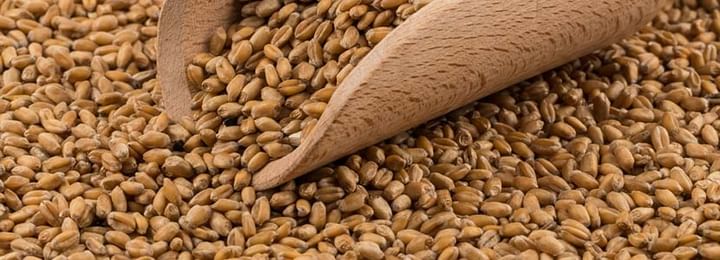Benefits of Spelt And Its Side Effects
Last Updated: Jan 20, 2025
The health benefits of Spelt is such that it helps in improving the digestive health, lowers the level of cholesterol, improves blood circulation, helps in hormonal regulation and creation, maintains bone health, helps in growth and development, helps in maintaining a healthy immune system, controls diabetes, helps patients with migraine headache, helps in preventing atherosclerosis & cardiovascular diseases, prevents development of gallstones and prevents breast cancer.
Spelt
Spelt is a variety of grain or cereal that is closely related to wheat. In fact, spelt likely developed from a hybridization of emmer wheat and wild goat-grass. It is closely related to normal “bread” wheat, but the popularity of bread wheat soon made spelt obsolete, which is why it is considered as a “relict” crop. However, it is making a comeback as a health food, particularly in Spain, the United Kingdom, and other parts of Europe. It is actually packed with nutrients, vitamins, minerals, and essential organic compounds that other cereals and forms of wheat don’t contain, which might explain the renewed interest in spelt. The scientific name of this ancient food staple is Triticum spelta, but it is more commonly known as hulled wheat or dinkel wheat.
Nutritional Value of Spelt
One cup of cooked spelt flour has about 246 calories of energy, 2 grams of fat, zero cholesterol, 10 milligrams of sodium, 51 grams of carbohydrate, 8 grams of dietary fibre, 11 grams of protein, 5 milligrams of niacin, 0.2 milligrams of thiamine, 0.2 milligrams of vitamin B6, 25 micrograms of folate, 0.5 milligrams of vitamin E, 2.1 milligrams of manganese, 291 milligrams of phosphorus, 95 milligrams of magnesium, 0.4 milligrams of copper, 3 milligrams of iron, 2 milligrams of zinc, 8 micrograms of selenium, 277 milligrams of potassium and 19 milligrams calcium.
Nutritional facts Per 100 Grams
Vitamins and Minerals
Health Benefits of Spelt
Helps in improving the digestive health
The very high-content of fibre in spelt implies that it facilitates healthy digestion in a major way. Dietary fibre helps to bulk up the stool and move food from the digestive system, accelerating the absorption of nutrition and assists to control situations like constipation, bloating, cramping, excessive gas, diarrhoea and much more severe intestinal issues just like ulcers. Spelt has the greatest dietary fibre contents than the other wheat varieties.
Helps in lowering the level of cholesterol
Dietary fibre features another important role within the body, which is to assist decrease in the amount of dangerous cholesterol within the body. Dietary fibre can communicate with the cholesterol uptake processes as well as prevent the absorption of cholesterol from food. In reality, it may specifically target LDL cholesterol and also eliminate it from the body to manage a healthy balance of fatty acids within the body.
Helps in improving blood circulation
The high amounts of iron and copper in spelt mix to considerably boost circulation of blood. Iron and copper are crucial in order to obtain red blood cells, and when RBC production is up, there is certainly increased blood circulation through the entire body, which suggests additional oxygenation to organs and tissues, increased healing, boosted energy levels, along with a more functional metabolism. Increased circulation may even enhance hair growth and the iron content on the other hand helps the body prevent becoming anaemic.
Helps in hormonal regulation and creation
Niacin is among the important vitamins that can be found in considerable amounts in spelt. Niacin performs a vital role in the adrenal glands within the body, especially in the manufacture of sex hormones. The endocrine system is really a delicate and hugely important factor for our health and general functioning, therefore maintaining healthy niacin levels with the addition of spelt in a person’s diet is highly recommendable.
Helps in maintaining bone health
Spelt comes with a remarkable range of important minerals which are essential for bone health. This includes zinc, magnesium, copper, phosphorous, and selenium. These types of minerals contribute to the formation of bone tissue and also by enhancing the levels of these minerals within the body, it is possible to actively avoid osteoporosis along with other age-related problems that weaken or degrade the bones within the body.
Helps in growth and development
The high amounts of phosphorous, combined with remarkable content of protein in spelt makes it extremely important for the development and growth of new tissues, blood vessels, muscles, bones, and organs. Phosphorous is among the important elements behind creating new proteins as well as making DNA to create new cells. The proteins which are received straight from spelt could be broken down into their composite amino acids and after that can be re-formed for use within the body for pretty much every essential body processes.
Helps in maintaining a healthy immune system
Thiamine is recognized to considerably enhance body’s immune system as well as stimulate its defensive mechanisms, whilst reducing psychological anxiety and stress. Spelt is probably the few cereals that may contain a substantial level of the vitamin-B.
Helps in diabetes control
Even though simple sugars and carbohydrates are recognized to be hazardous for diabetic patients, the high fibre content in spelt can combat the effects of diabetes and help to manage the release as well as the breakdown of simple sugars into glucose. By controlling the release of insulin and glucose within the body, it helps to manage diabetes for individuals who already have problems with the condition, or even prevent more people from developing it.
Helps patients with migraine headache
Consuming foods along with Riboflavin like spelt and other products of spelt is shown to decrease the regularity of migraine attacks. Consuming as little as two ounces of bread or any other baked good made out of whole grain spelt will gives about 76.5% of the daily requirement for Riboflavin.
Helps in preventing atherosclerosis & cardiovascular diseases
Atherosclerosis is the hardening of the arteries caused by high levels of bad cholesterol that also plays a role in cardiovascular disease. Niacin can help to eliminate the total cholesterol levels. Consuming spelt can improve Niacin intake in the body. Niacin may also help to decrease the development of blood clots. Moreover, the fibre present in spelt can help to eliminate the total as well as the LDL cholesterol levels within the body. Consuming whole grains like spelt at least 6 times every week is advisable for postmenopausal women with high cholesterol, high blood pressure or any other signs of cardiovascular disease. Consumption of spelt shows signs and symptoms of slowed progression of atherosclerosis.
Helps in preventing formation of gallstones
Research says that consuming foods loaded with insoluble fibre, like spelt, might help women prevent gallstones. The insoluble fibre not only speeds up the movement of food within the intestines, but decreases the secretion of bile acids, that in extreme amounts play a role in gallstone development. The insoluble fibre additionally boosts insulin sensitivity as well as lowers triglycerides in the body.
Prevents breast cancer
Fibres given by whole grains offer the most defence against breast cancer. Pre-menopausal women consuming the most whole grain fibre had about 41% reduced chances of developing breast cancer, than others with the lowest whole grain fibre intake.
Uses of Spelt
Spelt has a wide variety of uses. Spelt flour can substitute for modern ‘common’ wheat flour to make breads, pasta, cookies, crackers, cakes, muffins, cereals, pancakes and waffles. In addition to spelt flour, spelt is also available in its de-hulled, whole grain form (often referred to as spelt berries or dinkel berries), which can be prepared and enjoyed like rice.
Side-Effects & Allergies of Spelt
Spelt contains gluten, which may cause problem for people having celiac disease. Celiac disease is a serious digestive disorder that is increasing around the world. It’s also known as celiac sprue, nontropical sprue and gluten-sensitive enteropathy, and is sometimes triggered or activated by childbirth, pregnancy, severe emotional stress, surgery or a viral infection. In some studies when spelt flour was investigated for its toxicity on celiac disease patients, the results suggested that spelt is a celiac-toxic cereal and needs to be avoided. Excess consumption of spelt can also cause diarrhoea, bloating, abdominal pain, irritability, skin rash, muscle cramps, joint pain, upset stomach, or weakness and fatigue.
Cultivation of Spelt
Spelt is around 9000 years old. There are certain proofs that spelt grains were grown by ancient cultures both in Europe and also the Middle East 1000’s of years ago. It is pointed out in the Old Testament as well as in numerous Roman texts. Carbonated grains of spelt have been discovered all through Europe which includes Britain, in lots of Stone Age excavations. Its level of popularity remained prevalent, particularly in Eastern Europe, till the end of the 19th century. German records of one region, dated 1850, demonstrated that 94% of the cereal acreage was producing spelt and just 5% producing bread wheat. The rapid fall from favour of spelt was shown by rapid improvements in modern farming. Once mixed harvesters were introduced that could harvest common bread wheat in one process it might have no longer been so attractive for farmers to continue to grow spelt. This is due to every individual grain of spelt unlike common wheat is covered by the tough external husk that needs removal in the further process prior to grain could be milled into flour.
Thankfully spelt wasn’t completely lost to mankind and in the mid 1980’s it was rediscovered in Europe and it has undergone an important resurgence in lots of parts of the world ever since. Except for this to happen, particular machinery that could de-hull individual spelt grains in commercial amounts must be introduced in the chain of production to make flour. However by this stage it was realized by those taking the lead in this renaissance that the time and cost of having to do this far outweighed the benefits to both farmers and consumers of resurrecting this ancient grain.
References
- Arzani A, Ashraf M. Cultivated ancient wheats (Triticum spp.): a potential source of health‐beneficial food products. Comprehensive Reviews in Food Science and Food Safety. 2017 May;16(3):477-88. [Cited 26 June 2019]. Available from:
- Lacko-Bartošová MA. Nutritional quality and antioxidant capacity of triticum spelta varieties. Journal of Ecology and Health. 2010;14:290-4. [Cited 26 June 2019]. Available from:
- ScienceDirect. Spelt, Modern Techniques for Food Authentication (Second Edition) 2018 [Internet]. [Cited 26 June 2019]. Available from:
Table of content
Ask a free question
Get FREE multiple opinions from Doctors



